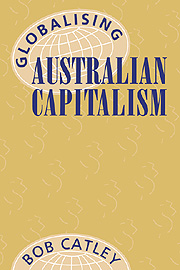Book contents
- Frontmatter
- Contents
- List of Tables
- List of Figures
- Preface and Acknowledgements
- List of Abbreviations
- Introduction
- 1 The International System and the End of the Cold War
- 2 The World Market and the Industrial Revolution in Asia
- 3 The Australian State and Economic Development
- 4 Economic Rationalism Changes Australian Politics
- 5 Government and Business in Australia
- 6 The Public Sector Reinvented
- 7 Australian Industry Restructures
- 8 Geographic Dimensions of Change
- 9 Australia Joins the Asia-Pacific Region: from ANZUS to APEC
- 10 All in a Day's Work
- Notes
- Index
2 - The World Market and the Industrial Revolution in Asia
Published online by Cambridge University Press: 14 January 2010
- Frontmatter
- Contents
- List of Tables
- List of Figures
- Preface and Acknowledgements
- List of Abbreviations
- Introduction
- 1 The International System and the End of the Cold War
- 2 The World Market and the Industrial Revolution in Asia
- 3 The Australian State and Economic Development
- 4 Economic Rationalism Changes Australian Politics
- 5 Government and Business in Australia
- 6 The Public Sector Reinvented
- 7 Australian Industry Restructures
- 8 Geographic Dimensions of Change
- 9 Australia Joins the Asia-Pacific Region: from ANZUS to APEC
- 10 All in a Day's Work
- Notes
- Index
Summary
During the last decade Australia has begun to see itself as part of the Asia-Pacific region. This has been manifested in a number of ways described later in Chapter 9, notably a reorientation of foreign policy towards the region, accelerated under Prime Minister Keating; a reformulation of defence policy to integrate Australia's strategy into regional configurations; and a new emphasis in Australian education policy to concentrate greater attention on Asia-Pacific issues. But underpinning this new awareness of the region lay profound economic changes which at first led to considerable alarm. During the 1970s it was widely feared, particularly in the Australian trade union movement and among the managers of protected industries, that the economic developments taking place in East Asia would be a potent threat to the Australian economy. It was feared that the combination of cheap labour, repressive governments, tax havens and export-oriented industrialisation would pose a challenge to Australian industry which it could not meet. During the last ten years a more mature perspective on economic growth in Asia has been developed. In addition, such growth is now being seen as an opportunity for the country as a whole, even though it may require changes and dislocations to pre-existing economic practices. In order to appreciate these challenges it is necessary to develop a balanced appreciation of the process of economic industrialisation at present under way in Asia.
Industrial Revolutions
It is common in popular economic development literature to talk of the Asian ‘miracle’. Indeed the World Bank in 1993 published a study of several East Asian economies, The East Asian Miracle, seeking to explain why their economic growth rates were so impressive.
- Type
- Chapter
- Information
- Globalising Australian Capitalism , pp. 26 - 42Publisher: Cambridge University PressPrint publication year: 1996



